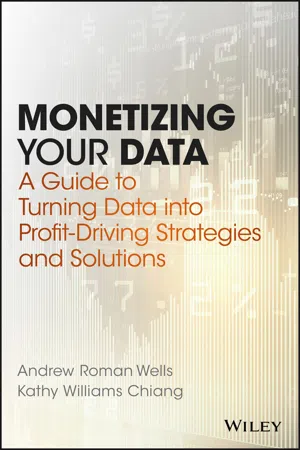
Monetizing Your Data
A Guide to Turning Data into Profit-Driving Strategies and Solutions
Andrew Roman Wells, Kathy Williams Chiang
- English
- ePUB (handyfreundlich)
- Über iOS und Android verfügbar
Monetizing Your Data
A Guide to Turning Data into Profit-Driving Strategies and Solutions
Andrew Roman Wells, Kathy Williams Chiang
Über dieses Buch
Transforming data into revenue generating strategies and actions
Organizations are swamped with data—collected from web traffic, point of sale systems, enterprise resource planning systems, and more, but what to do with it? Monetizing your Data provides a framework and path for business managers to convert ever-increasing volumes of data into revenue generating actions through three disciplines: decision architecture, data science, and guided analytics. There are large gaps between understanding a business problem and knowing which data is relevant to the problem and how to leverage that data to drive significant financial performance. Using a proven methodology developed in the field through delivering meaningful solutions to Fortune 500 companies, this book gives you the analytical tools, methods, and techniques to transform data you already have into information into insights that drive winning decisions. Beginning with an explanation of the analytical cycle, this book guides you through the process of developing value generating strategies that can translate into big returns. The companion website, www.monetizingyourdata.com, provides templates, checklists, and examples to help you apply the methodology in your environment, and the expert author team provides authoritative guidance every step of the way.
This book shows you how to use your data to:
- Monetize your data to drive revenue and cut costs
- Connect your data to decisions that drive action and deliver value
- Develop analytic tools to guide managers up and down the ladder to better decisions
Turning data into action is key; data can be a valuable competitive advantage, but only if you understand how to organize it, structure it, and uncover the actionable information hidden within it through decision architecture and guided analytics. From multinational corporations to single-owner small businesses, companies of every size and structure stand to benefit from these tools, methods, and techniques; Monetizing your Data walks you through the translation and transformation to help you leverage your data into value creating strategies.
Häufig gestellte Fragen
Information
SECTION IV
AGILE ANALYTICS
CHAPTER 8
Decision Theory: Making It Rational
Decision Matrix
| Parking Delays | No Parking Delays | |
| Uber car service | On-time arrival/$11 | On-time arrival/$11 |
| Drive self | Late for show/$0 | On-time arrival/$0 |
- Actionable—Among the core components of a decision matrix are the acts or decisions that we outline for the user. You need to make sure that decisions you are considering are actionable for the organization, particularly if you are in a large matrix organization. If the actions you outline are too difficult to implement, the analytical solution will probably not get off the ground.
- Rationalize Attributes—How many attributes or metrics do you need to show in your decision matrix to help someone make a decision? This may be one of the toughest questions to answer. While a natural tendency is to consider as much information as possible, we need to ask ourselves which metrics really drive the decision and focus on these.
- Payoff—You must determine a monetary value or some other utility derived from making the decision, like an on-time arrival to the show. This is the incentive to make the decision. In most of our work, we find adding a monetary value to the decision helps the analyst weigh the economic benefits versus the risks, leadi...
Inhaltsverzeichnis
- Cover
- Title Page
- Copyright
- Table of Contents
- Dedication
- Preface
- Acknowledgments
- About the Authors
- Section I: Introduction
- Section II: Decision Analysis
- Section III: Monetization Strategy
- Section IV: Agile Analytics
- Section V: Enablement
- Section VI: Case Study
- Bibliography
- Index
- End User License Agreement